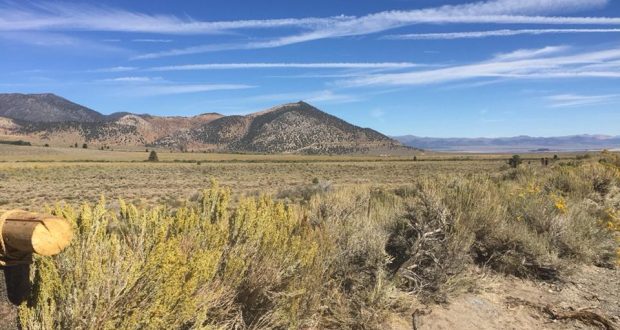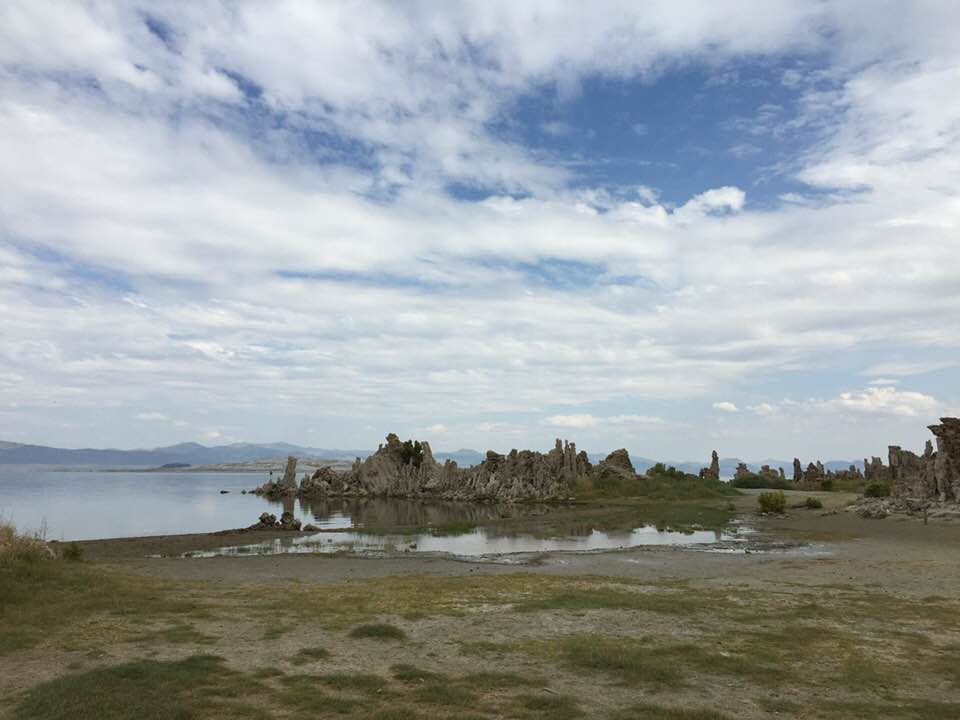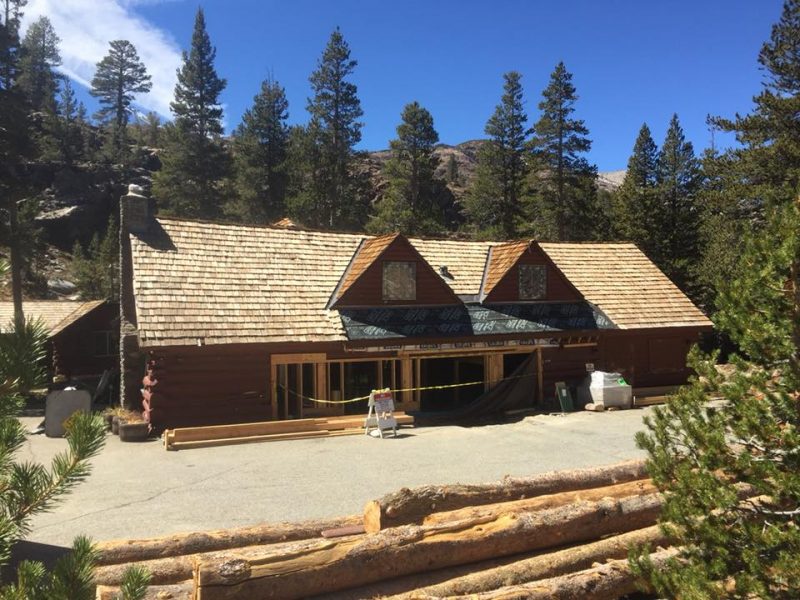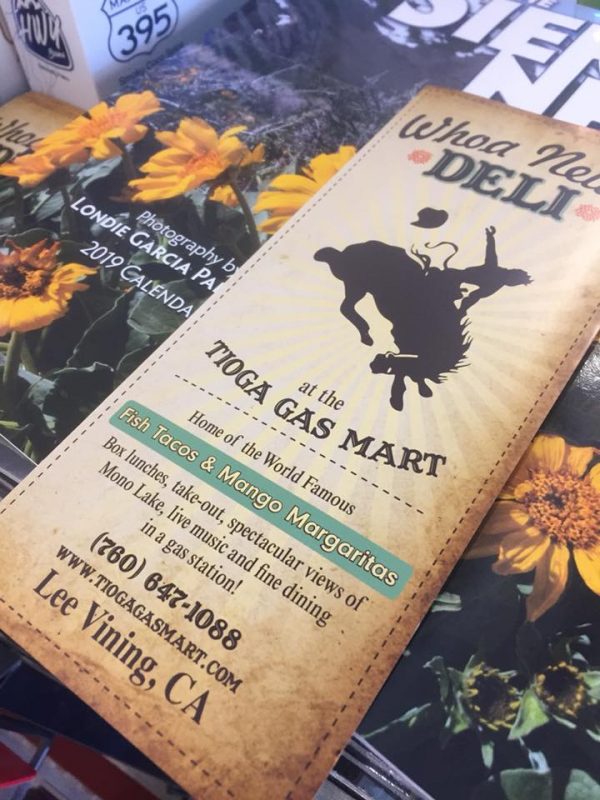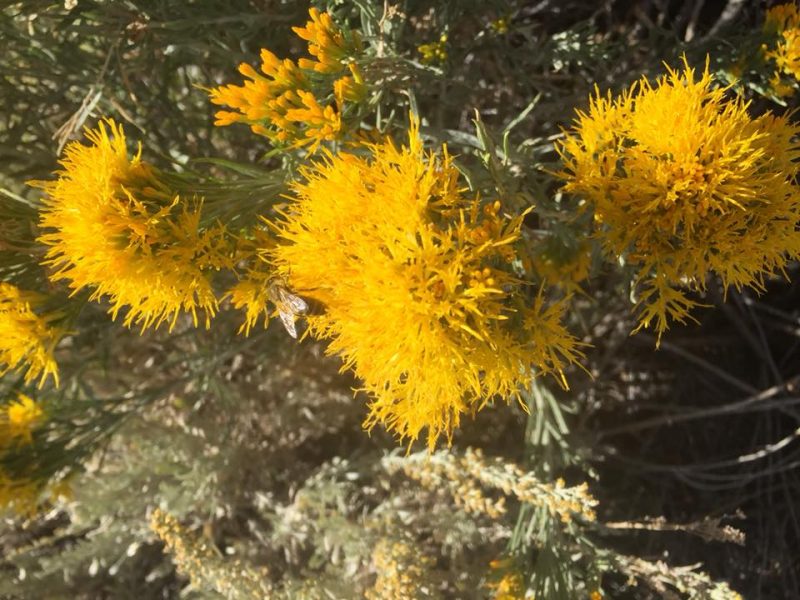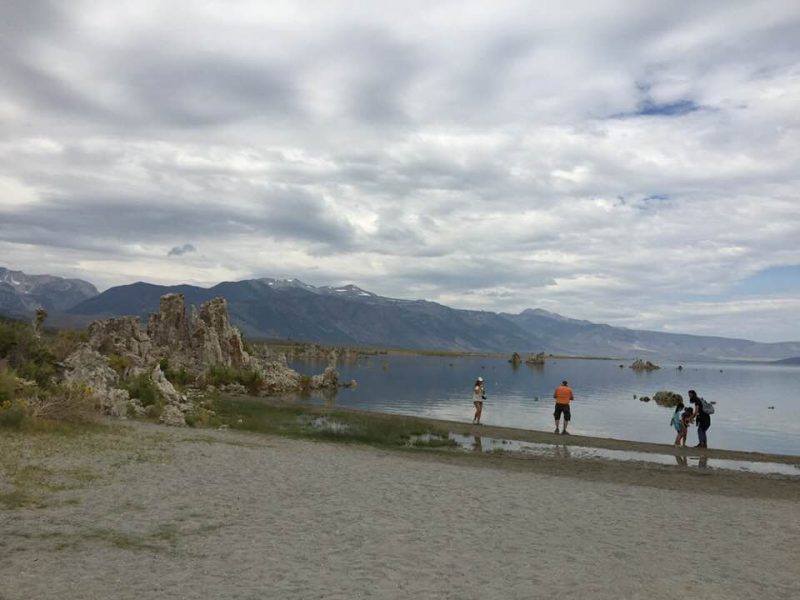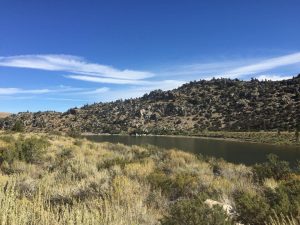 MOUNTAIN AREA — We decided to do something different this weekend, so the hubs and I took off from our home in Coarsegold on Saturday morning for a quick trip over Tioga Pass to see what we could find.
MOUNTAIN AREA — We decided to do something different this weekend, so the hubs and I took off from our home in Coarsegold on Saturday morning for a quick trip over Tioga Pass to see what we could find.
Typically, we are reservation-type people, but on this particular jaunt over to the Eastern Sierra, we decided to play it by ear. With no reservations, and two sleeping bags in the back of the car for just-in-case, we were excited for a 30-hour vacation.
We packed some snacks and drinks, gassed up in Oakhurst, and drove toward Yosemite’s south gate where there were a few cars and a bus in front of us, but the wait wasn’t long at all. My husband, Dave, flashed his senior pass and driver’s license and our adventure began in earnest.
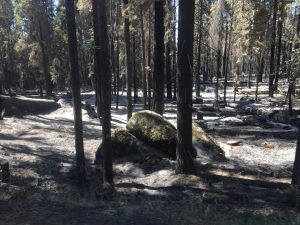 From the park entrance all the way across Tioga Pass, the changing landscape of Yosemite never ceases to impress. Now, just shy of fall, is as perfect a time to visit as any. Added to the picture this year, whether we like it or not, are acres of forest burned by the Ferguson Fire. Coming and going via Highway 41/Wawona Road in Yosemite, it’s easy to see where firefighters made their stands against the fire, marked in part by swaths of Pepto Bismol-pink remnants of fire retardant.
From the park entrance all the way across Tioga Pass, the changing landscape of Yosemite never ceases to impress. Now, just shy of fall, is as perfect a time to visit as any. Added to the picture this year, whether we like it or not, are acres of forest burned by the Ferguson Fire. Coming and going via Highway 41/Wawona Road in Yosemite, it’s easy to see where firefighters made their stands against the fire, marked in part by swaths of Pepto Bismol-pink remnants of fire retardant.
While the usual parts of Yosemite’s valley floor were crowded with visitors, the roads were fairly uncongested and the sky was a brilliant blue.
Tenaya Lake was glorious as ever, and scores of people played in the water and on the lake shores. We ticked off landmarks as we drove, with new amazing views around every corner.
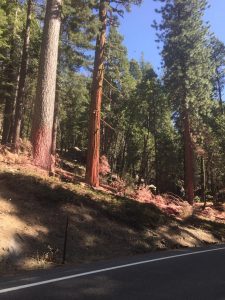 Our last stop before leaving the park was the store at Tuolumne Meadows, where we grabbed a hamburger and a chicken sandwich. We used the well-used restrooms and, in the ladies room at least, it was a BYOTP day: bring your own toilet paper, as they were short in some stalls.
Our last stop before leaving the park was the store at Tuolumne Meadows, where we grabbed a hamburger and a chicken sandwich. We used the well-used restrooms and, in the ladies room at least, it was a BYOTP day: bring your own toilet paper, as they were short in some stalls.
We traversed Tioga Pass toward Highway 395 somewhat breathlessly: the sweeping vastness of the land is impressive and the drop-off is no joke.
Finally arriving on the other side of the Sierra, we hadn’t even used a half a tank of gas, and here we were in a whole other world. The stark and jagged makeup of the volcanic and granite mountains are in stark contrast to the thickly forested Sierra near us in Yosemite.
According to a recent review by the Geological Society of America, the area from the Mono Lake basin to Mammoth Mountain is a world famous geologic feature known as the Long Valley Caldera. The caldera is 20 miles long, 11 miles wide and 3,000 feet deep. The areas’ hot springs, geothermal facilities, cinder cones and craters provide clear evidence of massive and minor eruptions from 760,000 to 40,000 years ago. Mammoth Mountain is a relatively recent volcanic peak on the edge of the caldera that erupted between 220,000 and 50,000 years ago. Paoha Island, in the middle of Mono Lake, is one of the youngest volcanic features in the area, erupting about 250 years ago. — Dave’s two cents.
This was a bit of a homecoming. Early in our romance and marriage, we spent a lot of time outside Bridgeport at Twin Lakes, where Dave and his rugby buddies built a cabin for his parents. It’s been a while since we’d been in that area — but we hadn’t forgotten the so-special sound of wind in the quaking aspen.
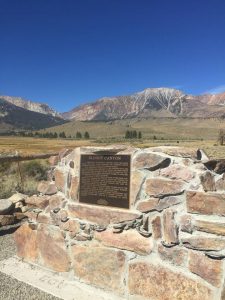 We took the June Lake Loop, passing a reservoir and some little lakes on our way. We also observed a large, notably crimson group of men surrounding a stone monument off to the side of the highway. We surmised correctly that they were members of E Clampus Vitus — Clampers — gathered to dedicate their most recent homage to local history: the remembrance of Bloody Canyon. More on that, later.
We took the June Lake Loop, passing a reservoir and some little lakes on our way. We also observed a large, notably crimson group of men surrounding a stone monument off to the side of the highway. We surmised correctly that they were members of E Clampus Vitus — Clampers — gathered to dedicate their most recent homage to local history: the remembrance of Bloody Canyon. More on that, later.
We got to June Lake mid-afternoon, and found there was a rock music festival happening nearby. We briefly checked it out, then decided to grab a room. Our first choice for lakeside accommodations was Big Rock Resort, but there was a two-night minimum and it was sold out, anyway. Pristinely landscaped, rustic and charming, with its own dock and boat rentals, we vowed to return someday with reservations in tow.
Ultimately we landed at Boulder Lodge, a comfortable family-owned resort overlooking the lake. Without any fuss, we secured a room with a little view, and set out to explore town a little bit. We walked around the main drag, checking out the shops and stopping for an ice cream cone — made mine a double.
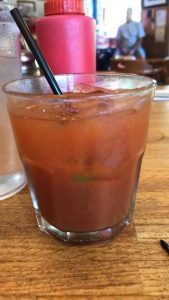 As it turned out, our dessert was but a prelude to dinner, as we decided to have a bite at the local watering hole, Tiger Bar and Cafe.
As it turned out, our dessert was but a prelude to dinner, as we decided to have a bite at the local watering hole, Tiger Bar and Cafe.
Hubs had a carnitas enchilada and I chose wisely, as well — the BLT on toasted sourdough was pretty much perfect, arriving hot and crispy with ideal ratios of lettuce and bacon, and just the right amount of mayonnaise. I can also personally recommend the hand-made house Bloody Mary. I did my research.
Leaving the Tiger Bar, where we’d seen a table-full of Clampers enjoying a brew after their dedication, we saw a bus pull up out in front of the restaurant and a sea of red emerge. More Clampers, and they were heading right into the bar we were leaving. One carried — and beat — a giant drum, as if for a marching band. We agreed our timing was ideal as we made room for the red-shirted revelers to eat, drink, and be Clampers.
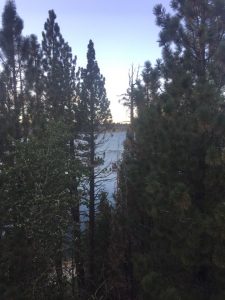 After our early dinner, we drove around the lake to see where we could access a shady spot — it was unusually warm for a September day, with temps pushing past 80 degress. Back on our balcony it was cool and beautiful, and we could see the lake, so we decided to relax. I had a an appointment with a book — my responsibility as a member of Branches Book Club — and my better half wanted to explore the lake from Boulder Resort. It was steep, but he managed to make it there and back.
After our early dinner, we drove around the lake to see where we could access a shady spot — it was unusually warm for a September day, with temps pushing past 80 degress. Back on our balcony it was cool and beautiful, and we could see the lake, so we decided to relax. I had a an appointment with a book — my responsibility as a member of Branches Book Club — and my better half wanted to explore the lake from Boulder Resort. It was steep, but he managed to make it there and back.
Forgoing the rock concert, we napped in our room and ate vending machine snacks for dinner, agreeing we’d had a long day of travel and there was nothing wrong with a quiet night on the lake. As the sun set over June Lake, we decided to call it a night and plan for the next day.
Morning was cool on the lake, and we checked out a few resorts and campsites for future reference, as we made our way along the Highway 158 loop toward Highway 395.

We pulled over when we saw the Bloody Canyon monument, and sure enough, there were a couple of guys there who were willing to fill us in on the details of the commemoration. They’d even bestowed the ashes of a beloved member atop the stoneworked structure, washing it down with beer as one would want.
A distinctive geological feature along the Mono Trail for many years provided the shortest route between the Mono Basin and Yosemite Valley. Lt. S. Treadwell Moore (Co. B, 2nd Infantry, USA) and his detachment are credited with being the first white men to traverse Bloody Canyon (west to east) in 1852. His reports would later influence others to explore this region of the Sierra Nevadas.
Reportedly, it was named because of the dark red rocks that compose the canyon walls and surface of the rugged steep trail. Those jagged and sharp rocks mercilessly lacerate the feet, ankles and legs of unprepared animals and humans. One legend has it the rocks were stained red by the blood shed during a fierce battle between warring local native American tribes many years ago.
During its heyday, many explorers, prospectors and settlers braved the riggers of Bloody Canyon and forever established this as a landmark of Mono County. — dedicated Sept. 8, 2018, Bodie Chapter No. 64, E Clampus Vitus
Next stop was the Mobile Station at Lee Vining on 395.
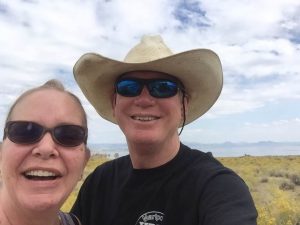 They’re known for the food at the Whoa Nellie Deli, for good reason. I had the pancakes with sausage and syrup, and it was worth the extra calories. Hubs had a breakfast burrito. There’s a theme for you. Naturally, because the world is very small indeed, we briefly ran into someone we knew from back at home — Yosemite High School teachers on a well-earned weekend themselves. The Mobile is also known for concerts on Thursdays and Sundays during the summer months.
They’re known for the food at the Whoa Nellie Deli, for good reason. I had the pancakes with sausage and syrup, and it was worth the extra calories. Hubs had a breakfast burrito. There’s a theme for you. Naturally, because the world is very small indeed, we briefly ran into someone we knew from back at home — Yosemite High School teachers on a well-earned weekend themselves. The Mobile is also known for concerts on Thursdays and Sundays during the summer months.
Driving through Lee Vining, we took a semi-wrong turn (that is, I knew that what I was doing was wrong and did it, anyway) that led us to perhaps the most laugh-out-loud moment of this trip. We stopped at the Mono Basin History Museum and saw, among other treasures, the Upside Down House.
The Upside Down House is the brainchild of Nellie Bly O’Bryan (1893–1984), described as a visionary entrepreneur, and long time resident of the Mono Basin.
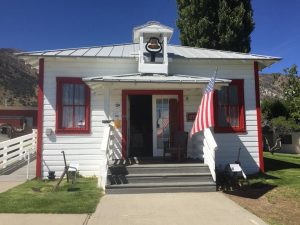 With a deep respect for whimsy, after seeing a miners’s cabin tipped on its roof, she carefully constructed the home upside down, wall to wall, floor to ceiling. The detail is remarkable, and you can step right in. I laughed aloud as I looked around the room, gazing up at a bed, and a rug, and a potty. Keep looking until you find the mouse.
With a deep respect for whimsy, after seeing a miners’s cabin tipped on its roof, she carefully constructed the home upside down, wall to wall, floor to ceiling. The detail is remarkable, and you can step right in. I laughed aloud as I looked around the room, gazing up at a bed, and a rug, and a potty. Keep looking until you find the mouse.
Being who we are, Dave and I could not wait to get over to the Mono Basin Forest Service Visitor Center at Mono Lake. It’s a beautiful building, and outside they’ve perched a giant’s handful of rock samples found locally, like obsidian — the size of storage locker. I love how, the second you walk into the very hands-on exhibit hall, the temperature cools and you hear sea gulls soaring above — it sets the mood for what you’re about to see.
Mono Lake was as glorious as it was the day we first kayaked together there, on our honeymoon nearly 23 years ago. We kayaked then with a geologist who explained in detail the delicate balance of the region and its geologic history.
Mono Lake supports one of the largest populations of inland shorebirds in the world. Half of all California Gulls in the state are hatched on the Mono Lake islands, and the brine shrimp and alkali flies are critical food sources for the millions of migrating birds that stop over to fatten up before continuing their long distant flights. — Dave’s two cents.
Now, we have our own kayak, and love paddling together and with friends on our own beautiful Bass Lake. Part of the purpose of our weekend blast-across-Tioga was to do recon for future kayak trips. We can’t wait to get back on Mono Lake with our own kayak, or with Caldera Kayaks, a local company available to get you on the water.
By this time, we were ready to head back into the park and over the pass to our home. We took a few detours along the way, to look at campsites for future reference. We pulled over at the Tioga Pass Resort, where they’re busy rebuilding after a monsterous winter. It’s looking good! You can follow their progress here.
Driving home, we marveled at our prime location, perched as we are at the gateway to Yosemite. We love to hang out in Eastern Madera and Mariposa counties — who wouldn’t? But it was also fun to get out and play tourist, and plot our return to the Eastern Sierra.

